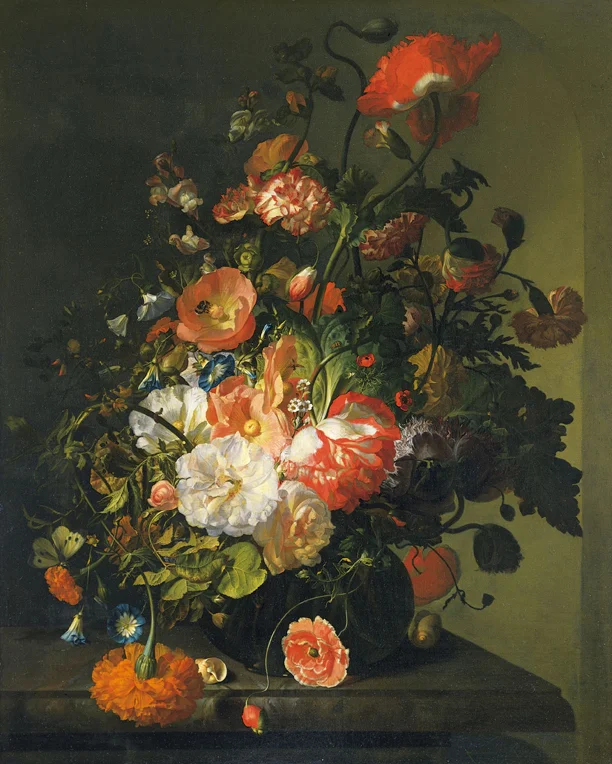dutch mastery
I have a habit of falling down rabbit holes of obsession. One thing leads to another and suddenly a simple query about pet-friendly lumber has turned into a week-long escapade into the history of chromated copper arsenate and how it relates to the climate of New Orleans and Brad Pitt's charitable activities. This has happened with topics as wide-ranging as Kara Walker, authorial self-promotion, the ghosts of North Brother Island, and whores in early modern London (at least I got a Ph.D. out of the one). The internet seems to embolden obsessive types, handing them a megaphone to shout into the abyss.
Most recently, being engaged has led me into the strange new realm of weddings. To call its denizens 'obsessed' is to put it mildly. You cannot grasp the mania of the modern wedding until you have attempted to plan one yourself, until you've been baptized in the frothy blush-tones of Pinterest and emerged wondering if you really might care about quirky tablescapes. You feel a bit like Christ, stumbling around the desert, sunburnt and seeing visions. 'All this I will give you,' saith Style Me Pretty, 'if you will bow down and worship me.' It was in the midst of this mania that I discovered the cool, dark shade of Saipua, and the end of the world.
About a decade ago, in a corner of Brooklyn that the subway still doesn't visit, Sarah Ryhanen started Saipua in order to sell her mother's soaps and try her hand at floral arrangements. Fast-forward a few years and (although she'd balk to hear it) Sarah has pretty much transformed floral aesthetics, inspiring a generation of young floral designers to break away from the constraints of formalism. She and Nicolette Owen started the Little Flower School, where they teach their students to eschew tight, spherical shapes and instead draw upon the loose, asymmetrical style of arrangement seen in the still-life paintings of the Dutch Golden Age.
You should hear Sarah Ryhanen talk about flowers. She doesn't gush. She isn't saccharine. Wearing the grim, resolute expression of a Flemish portrait, she names each stem with authority and reverence--'iris', 'delphinium', 'viburnum'--truly, Adam in the garden with Nicolette as her Eve (of course, with that Titian hair!) On a frigid March day, a group of us gathered at their feet to witness alchemy. This was the Little Flower School's Dutch Masters Class.
After lectures and pour-over coffees, we shopped for flowers in a hallway lined with opulent parrot tulips and delicate fritillaria. I was a little concerned that there would be a stampede for the best ranunculi but it turns out that flower people are quite civilized. It also turns out that everyone's definition of 'best' is different, which was probably my favorite part of flower class.
Every student, regardless of experience, managed to achieve something completely transcendent. Some of them were professional florists from far-flung places, others were utter neophytes like myself. I wish I could have had more time to talk to my fellow students, to find out what brought them to the class.
For my part, I've loved flowers my whole life. As a kid I was often found wandering around the garden, poring over Cicely Mary Barker's books and looking for fairies. For awhile, I secretly harbored the same dream as Eliza in My Fair Lady ("I want to be a LAY-dee in a FLAAAH shop") but it didn't occur to me that I could ever arrange flowers myself--that seemed like an impenetrable, mysterious art.
And so it is, in some ways. To watch Sarah and Nicolette work you'd think there was nothing to it at all, but let me tell you, making arrangements like theirs requires a paradoxical combination of delicacy and brute force that doesn't come easy. Sure, you can jam a branch of cherry blossom into your chicken wire, but can you make it stay? Narcissus and muscari are lovely but their crushable stems are a nightmare. I spent the whole afternoon fiddling with the position of a gorgeous green tulip only to decapitate it by mistake. I now get why the rose is the ubiquitous queen of flower arrangements--that stem can take a beating. I've never had such appreciation for what goes on under the petals in a flower arrangement. There's a whole story down there.
When the arrangements were done, we had them photographed one by one on a table styled with satin, old books, a skull, a few dappled quail eggs (I wish there had been a dead pheasant.) While we waited, I chatted with Sarah, although meeting someone you admire is always a deeply awkward business. You feel a bit like the guy at the party who has read people's name-tags but knows he should pretend he hasn't.
Jess Kwong's flower arrangement from Little Flower School, ph. Holly Carlisle
Back to flowers. Sarah grows hers on a farm 3.5 hours upstate called World's End. She and her partner, Eric, raise chickens and Icelandic sheep and are locked in an epic battle with a family of tenacious beavers. She is frank about how little the two of them knew to begin with and how difficult it is to farm. They make me think of the "Architect's Brother" series by the ParkeHarrisons--two people laboring together, wrangling the clouds and making the ground tick at the very ends of the earth. I wish I could see it.
The loveliest thing about working with flowers is that the medium shapes the results. You bring some ideas to the vessel, but the way the flowers fall is always a bit of a divine mystery. Toward the end of the afternoon, I found myself wandering around the third floor of the Metropolitan Building, looking for a good spot to take a photo. In a little red room, I set the flowers down, stepped backwards, and was visited upon by the spirit of Vermeer in the form of one perfect swath of light. Alchemy indeed.




